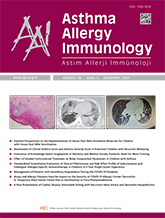


Objective: Allergen-specific immunotherapy (allergen-SIT) is a treatment method with variable efficacy in allergic diseases. This study aimed to investigate the effectiveness of allergen immunotherapy, frequency of LRs and SRs and variables affecting these parameters in patients who underwent allergen-SIT.
Materials and Methods: In this study, the recorded data of 81 patients, who received subcutaneous (SCIT) or sublingual (SLIT) allergen immunotherapy for respiratory allergic diseases between 2014 and 2019, were analyzed. In asthma and/or allergic rhinoconjunctivitis (ARC) patients, the effectiveness of treatment was evaluated by analysing the change rates in disease symptom, medication and combined scores (symptom + medication) and visual analog score (VAS). Treatment success was defined by the degree of decrease in scores as; high response above 50%; low response between 20-50%; and failure <20%.
Results: The mean age of allergen-SIT initiation was 11.4± 3.1 years. Diagnostic distributions of the patients were asthma (± ARC) in 64.2%, and ARC (without asthma) in 35.8%. The mode of allergen-SIT was SCIT in 77.8% (65% asthma and 35% ARC) and SLIT in 22.2% (61.1% asthma and 38.9% ARC). The main allergens used in allergen-SIT were mite (79%), grass-grain pollen (33.3%), alternaria (9.9%) and olea (8.6%). There was a significant decrease in symptoms, medication, combined and VAS scores in the asthma and ARC groups (p <0.0001), when end-SCIT values were compared to baseline. SLIT also resulted in significant decreases in these scores except asthma medication score. Among the asthma patients the rate of high-responders was 88.8% by SCIT and 50% by SLIT, according to combined asthma score. Among the ARC (without asthma) patients the rate of high-responders was 100% for both SCIT and SLIT. SCIT resulted in local (LR) and systemic side effects (SR) in 18% and 0.6% (all Grade I and Grade II) of the total injections performed. A high number of total injections was significantly associated with higher LR and SR rates. While LR was observed in 16.6% of the patients who underwent SLIT, no systemic reaction was found in any of the patients.
Conclusion: SCIT was highly successful in the treatment of asthma and ARC in terms of the degree of therapeutic response. SLIT resulted in a high rate of good response in ARC patients, but a lower response degree in asthmatic patients. Systemic side effects were very low as a result of close risk monitoring and the dose adjustments performed.